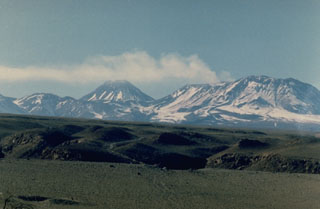Report on Lascar (Chile) — 7 December-13 December 2022
Smithsonian Institution / US Geological Survey
Weekly Volcanic Activity Report, 7 December-13 December 2022
Managing Editor: Sally Sennert.
Please cite this report as:
Global Volcanism Program, 2022. Report on Lascar (Chile) (Sennert, S, ed.). Weekly Volcanic Activity Report, 7 December-13 December 2022. Smithsonian Institution and US Geological Survey.
Lascar
Chile
23.37°S, 67.73°W; summit elev. 5592 m
All times are local (unless otherwise noted)
SERNAGEOMIN reported that an eruption at Láscar began at 1236 on 10 December with an explosive event that produced a dense ash plume and pyroclastic flows proximal to the crater. Hikers were near the crater and took video of the eruption. According to SEGEMAR the pyroclastic flows traveled short distances to the N and SE. The ash plume rose about 6 km above the crater rim and drifted SW. The event was coincident with a long-period earthquake detected by the seismic network. Later that day the Alert Level was raised to Yellow (the second lowest level on a four-color scale) and the public were warned to stay at least 5 km away from the crater. ONEMI declared an Alert Level Yellow (the middle level on a three-color scale) for San Pedro de Atacama (70 km NW). CKELAR noted that the thermal anomaly had intensified during the five days prior to the eruption along with increased sulfur dioxide gas emissions.
Geological Summary. Láscar is the most active volcano of the northern Chilean Andes. The andesitic-to-dacitic stratovolcano contains six overlapping summit craters. Prominent lava flows descend its NW flanks. An older, higher stratovolcano 5 km E, Volcán Aguas Calientes, displays a well-developed summit crater and a probable Holocene lava flow near its summit (de Silva and Francis, 1991). Láscar consists of two major edifices; activity began at the eastern volcano and then shifted to the western cone. The largest eruption took place about 26,500 years ago, and following the eruption of the Tumbres scoria flow about 9000 years ago, activity shifted back to the eastern edifice, where three overlapping craters were formed. Frequent small-to-moderate explosive eruptions have been recorded since the mid-19th century, along with periodic larger eruptions that produced ashfall hundreds of kilometers away. The largest historical eruption took place in 1993, producing pyroclastic flows to 8.5 km NW of the summit and ashfall in Buenos Aires.
Sources: Servicio Nacional de Geología y Minería (SERNAGEOMIN), Servicio Geológico Minero Argentino (SEGEMAR), Instituto Milenio de Investigación en Riesgo Volcánico (CKELAR), Red Geocientífica de Chile

